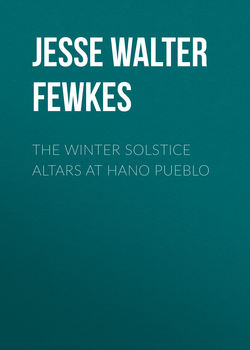Читать книгу The Winter Solstice Altars at Hano Pueblo - Jesse Walter Fewkes - Страница 1
Introduction
ОглавлениеThe fetishes displayed in their kivas by different phratries during the Winter Solstice ceremony at the Hopi pueblo of Walpi, in northeastern Arizona, have been described in a previous article,1 in which the altar made in the Moñkiva, or "chief" ceremonial chamber, by the Patki and related people has been given special attention. The author had hoped in 18982 to supplement this description by an exhaustive study of the Winter Solstice ceremonies of all the families of the East Mesa, but was prevented from so doing by the breaking out of an epidemic. This study was begun with fair results, and before withdrawing from the kivas he was able to make a few observations on certain altars at Hano which had escaped him in the preceding year.
Walpi, commonly called by the natives Hopiki, "Hopi pueblo," began its history as a settlement of Snake clans which had united with the Bear phratry. From time to time this settlement grew in size by the addition of the Ala, Pakab, Patki, and other phratries of lesser importance. Among important increments in modern times may be mentioned several clans of Tanoan ancestry, as the Asa, Honani, and the like. These have all been assimilated, having lost their identity as distinct peoples and become an integral part of the population of Walpi, or of its colony, Sitcomovi.3 Among the most recent arrivals in Tusayan was another group of Tanoan clans which will be considered in this article. The last mentioned are now domiciled in a pueblo of their own called Hano; they have not yet, as the others, lost their language nor been merged into the Hopi people, but still preserve intact many of their ancient customs.
The present relations of Hano to Walpi are in some respects not unlike those which have existed in the past between incoming clans and Walpi as each new colony entered the Tusayan territory. Thus, after the Patki people settled at the pueblo called Pakatcomo,4 within sight of Old Walpi, they lived there for some time, observing their own rites and possibly speaking a different language much as the people of Hano do today. In the course of time, however, the population of the Patki pueblo was united with the preëpre Walpi families, Pakatcomo was abandoned, and its speech and ritual merged into those of Walpi. Could we have studied the Patki people when they lived at their former homes, Pakatcomo or Homolobi, we would be able to arrive at more exact ideas of their peculiar rites and altars than is now possible. Hano has never been absorbed by Walpi as the Patki pueblos were, and the altars herein described still preserve their true Tanoan characteristics. These altars are interesting because made in a Tanoan pueblo by Tewa clans which are intrusive in the Hopi country, and are especially instructive because it is held by their priests that like altars are or were made in midwinter rites by their kindred now dwelling along the Rio Grande in New Mexico.
The midwinter rite in which the altars are employed is called Tûñtai by the Tewa, who likewise designate it by the Hopi name Soyaluña. This latter term may be regarded as a general one applied to the assemblages of different families in all the kivas of the East Mesa at that time. The name of the Tewa rite is a special one, and possibly the other families who assemble at this time once had or still retain their own names for their celebrations. The Tûñtai altars were brought by the ancestors of the present people of Hano from their old eastern home, and the rites about them are distinctly Tewan, although celebrated at the same time as the Winter Solstice ceremonies of the Hopi families.
1
The Winter Solstice Ceremony at Walpi (American Anthropologist, vol. XI).
2
These studies were made under the auspices of the Bureau of American Ethnology.
3
Most of the people of Sitcomovi are of the Asa and Honani clans, of Tanoan ancestry, but they long ago lost the Tewa language and their Tanoan identity.
4
The site of this last settlement of the Patki people, before they joined those of Walpi, is in the plain about four miles south of the East Mesa. The ruins of the pueblo are still visible, and the foundation walls can readily be traced.
